Table of Contents
Pelvic Fractures Can Be Stable & Unstable
- Unstable Fx: a result of high energy trauma with >50% d/t MVA
- 20% closed Fx and 50% of open Fx result in mortality
- Mortality is associated with vascular and internal organs injuries
- Vascular injury: 20% arterial 80% venous
- Chronic morbidity/disability and prolonged pain
- Unstable Fx are rarely seen in the outpatient setting and typically and present to the ED
- Stable pelvic Fx are usually caused by muscles/tendons avulsions and more often seen in pediatric cases

Understanding Pelvic Anatomy Is The Key To Successful Imaging Dx
- The bony pelvis is a continuous ring of bone held by strong ligaments
- During significant impact, pelvic fractures may occur in more than one location because forces applied to one region of the ring will also correspond to injury on the other, usually the opposite side of the ring (above image)
- Thus the majority of unstable pelvic Fx will typically demonstrate more than one break
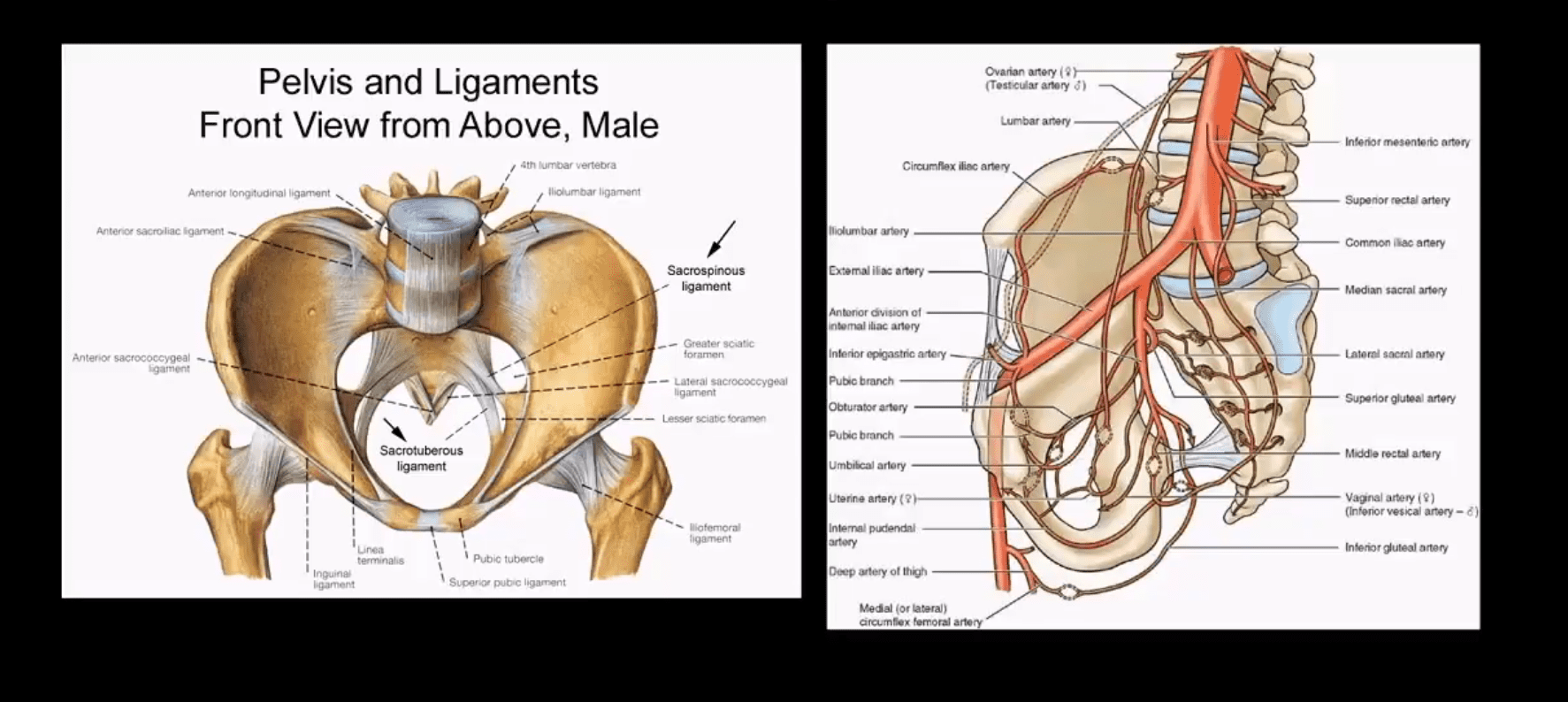
- Pelvic is seen as a ring of bone connected by some of the strongest ligaments in the body
- The pelvic ring comprises 2-semirings: anterior to the acetabulum and posterior to the acetabulum
- The bony pelvis is in close proximity to major vessels carrying a greater chance of vascular injury
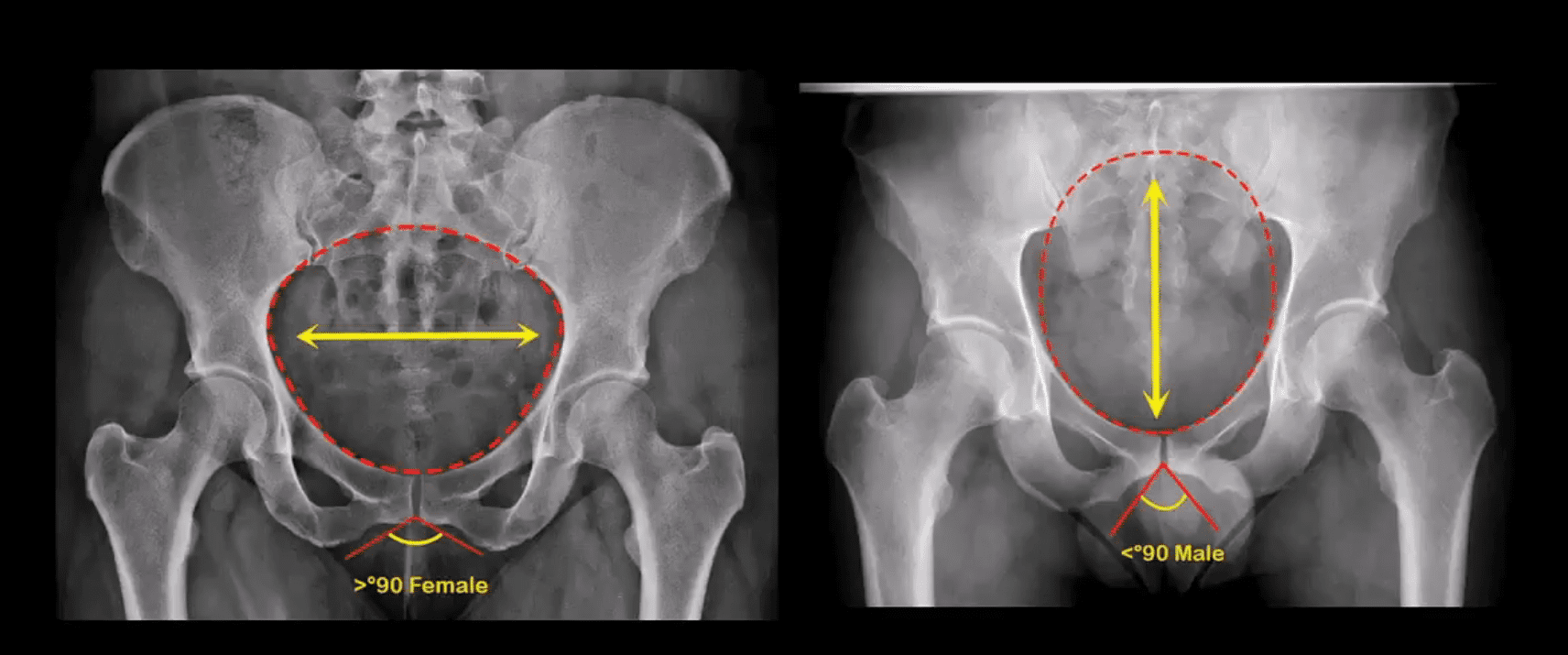
- Anatomical Differences of The Female and Male Pelvis
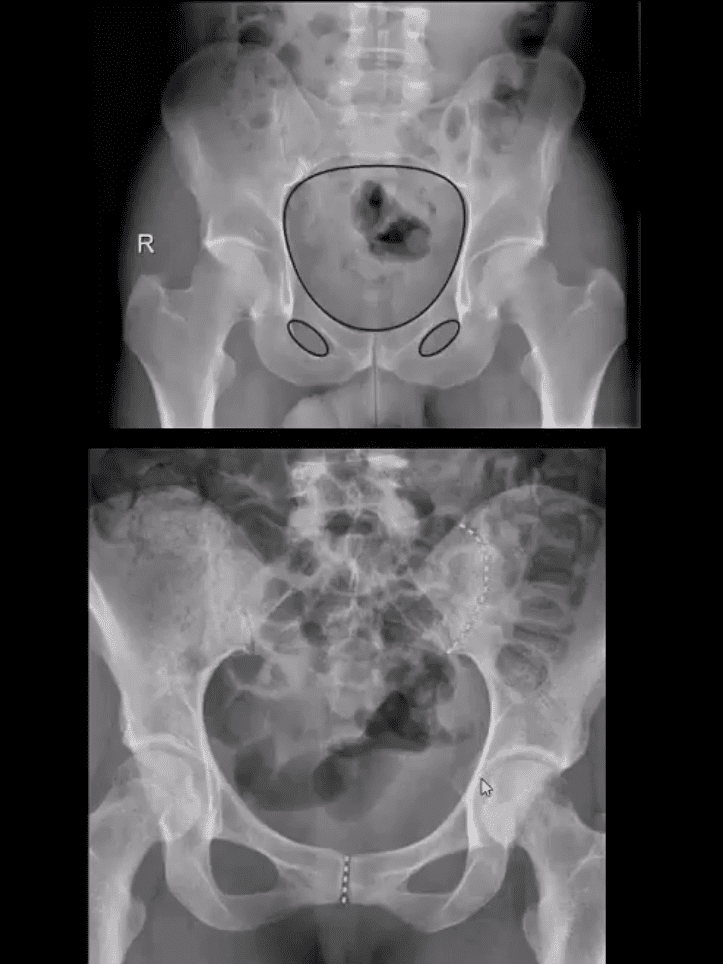
Post Traumatic Pelvic Views May Vary and Include:
- Standard AP Pelvis (above images)
- Judet views evaluating the acetabulo-pelvic region
- Inlet/Outlet views helping with the symphysis and SIJ regions
- Rad survey of the pelvis should include evaluation of the continuity of pelvic rings:
- Inlet/outlet, obturator rings (above the first image)
- Symphysis pubis and SIJ for diastasis and post-trauma separation (above the second image)
- Lumbosacral spine and hips should also be carefully examined
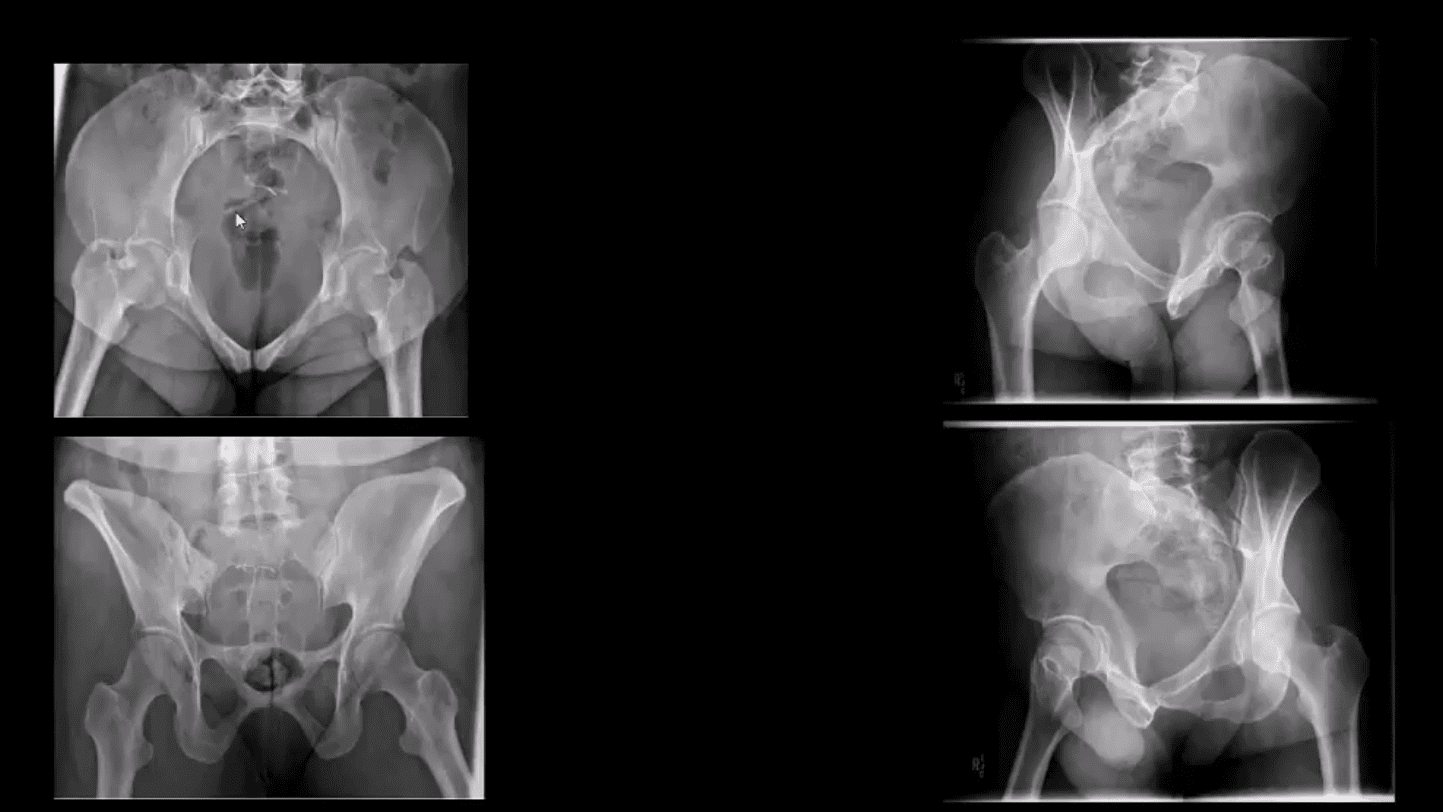
- Pelvic inlet (above top left) and Outlet (above bottom left)
- Judet views: left and right posterior oblique views
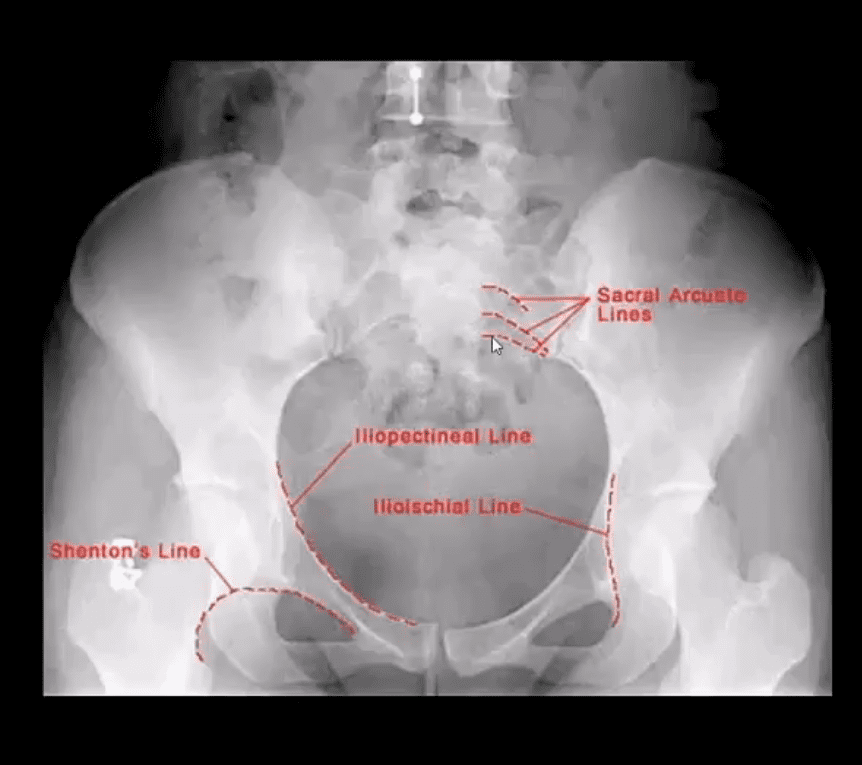
Additional Survey:
- Iliopectineal, ilioischial, Shenton and Sacral arcuate lines will help detection of sacral, acetabular and hip fracture/dislocations
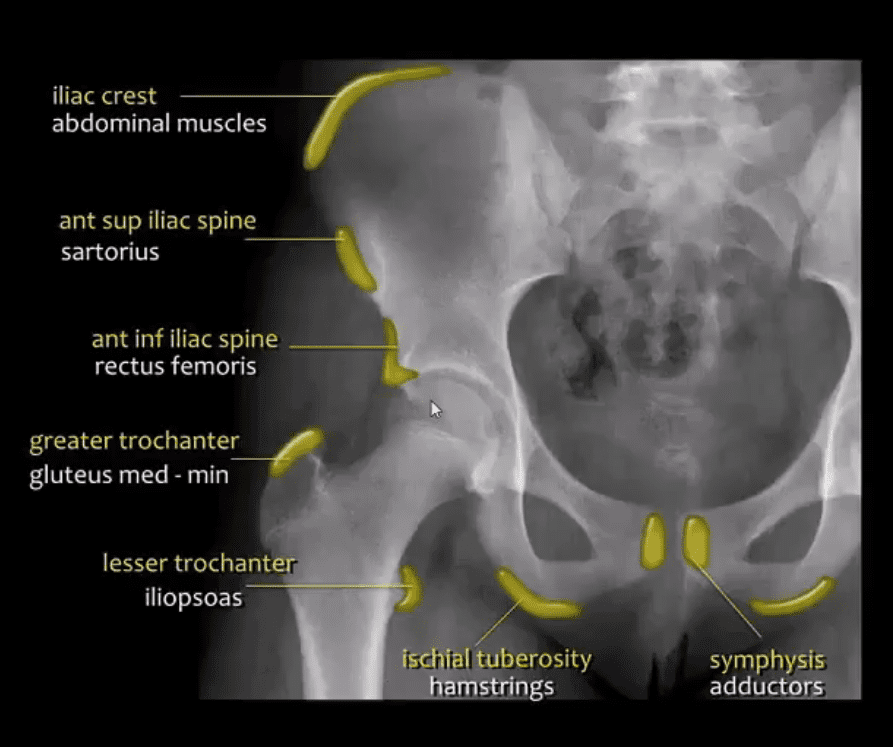
Stable Pelvic Fractures aka Avulsion Injury
- Appreciating anatomical sites of pelvic origin/insertion of different muscles will help Dx of pelvic avulsion Fx
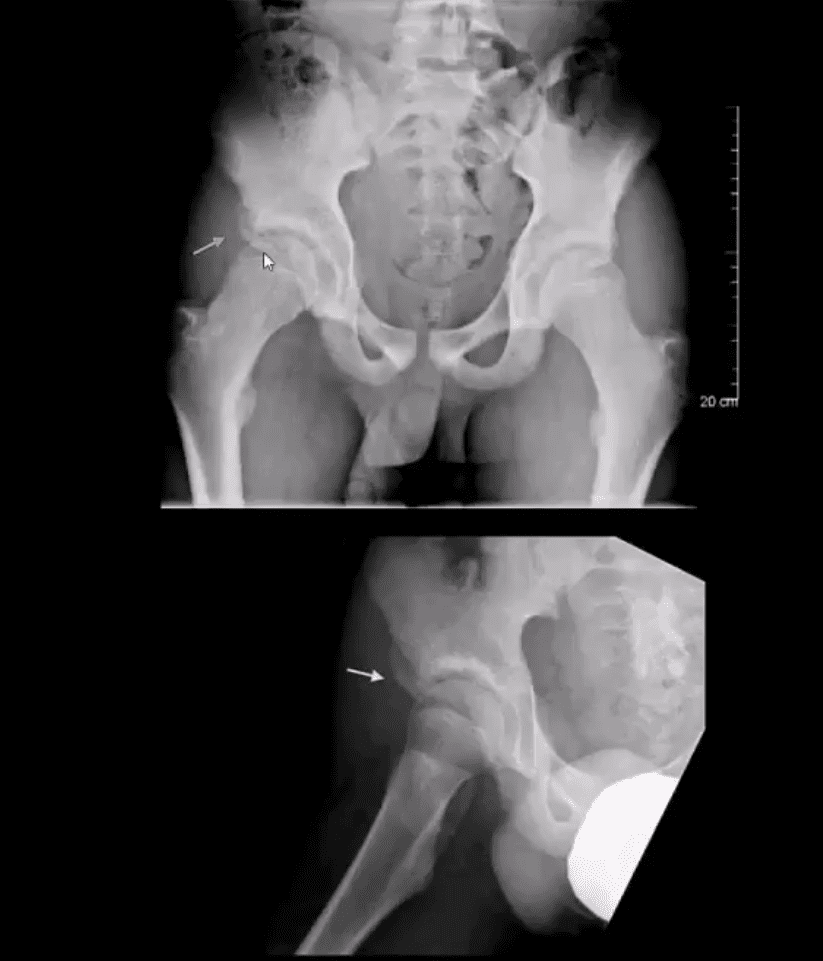
- Avulsion Fx of the AllS (origin of
the direct head of Rectus femoris M) - Pelvic avulsions occur by sudden eccentric contraction especially during kicking or jumping
- Imaging: x-radiography will suffice
- Clinically: sudden snap or pop followed by local pain. Pt can weight bear
- Care: non-operative with rest for 4-weeks. Non-union is rare. No major complications
- DDx: key rad DDx feature is not to mistake an avulsion from an aggressive pediatric bone tumor-like osteosarcoma that may show some exuberant new bone formation d/t healing and bone callus
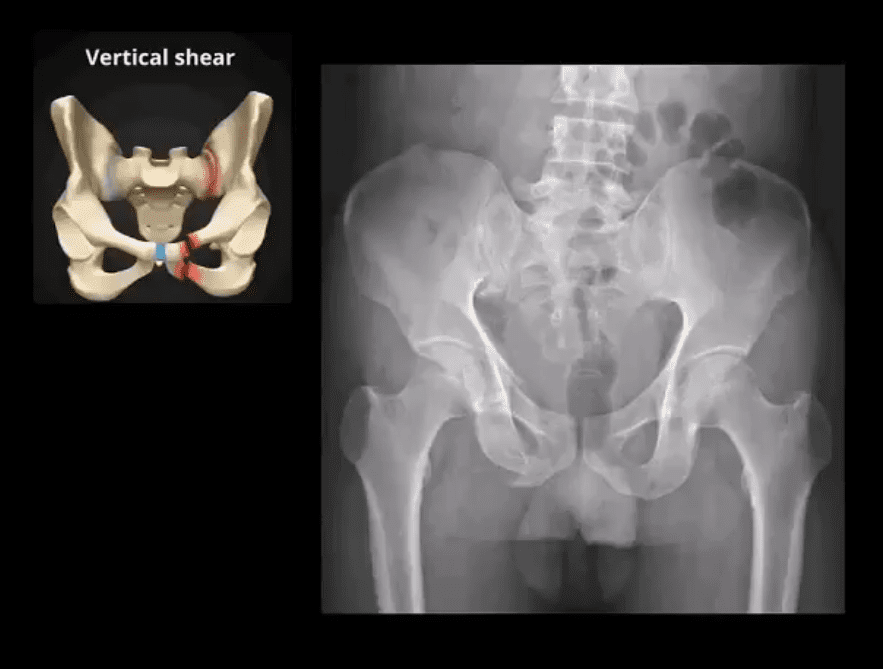
Commonly Encountered Unstable Pelvic Fractures
- Malgaigne Fx: d/t vertical shear injury to the ipsilateral pelvis
- Rad Dx: ipsilateral superior and inferior pubic rami Fx (anterior ring) with ipsilateral SIJ separation/Fx of the sacrum and adjacent ilium (posterior ring). Symphysis pubis diastasis can be seen. Additional clue is an avulsion of L4 and/or L5 TP that often signifies serious pelvic injury
- Clinically: marked leg shortening, shock, inability to weight bear.
- Damage to Superior Gluteal Artery can occur
- Imaging: x-radiography followed by CT scanning w/o and with IV contrast esp. if visceral injury present
- Care: surgical in most cases d/t major instability. ORIF. Hemostasis, Pelvic stabilization
- Prognosis: depends on the complexity, rate of visceral complications and stability. 10% Superior glut artery bleed requiring rapid hemostasis
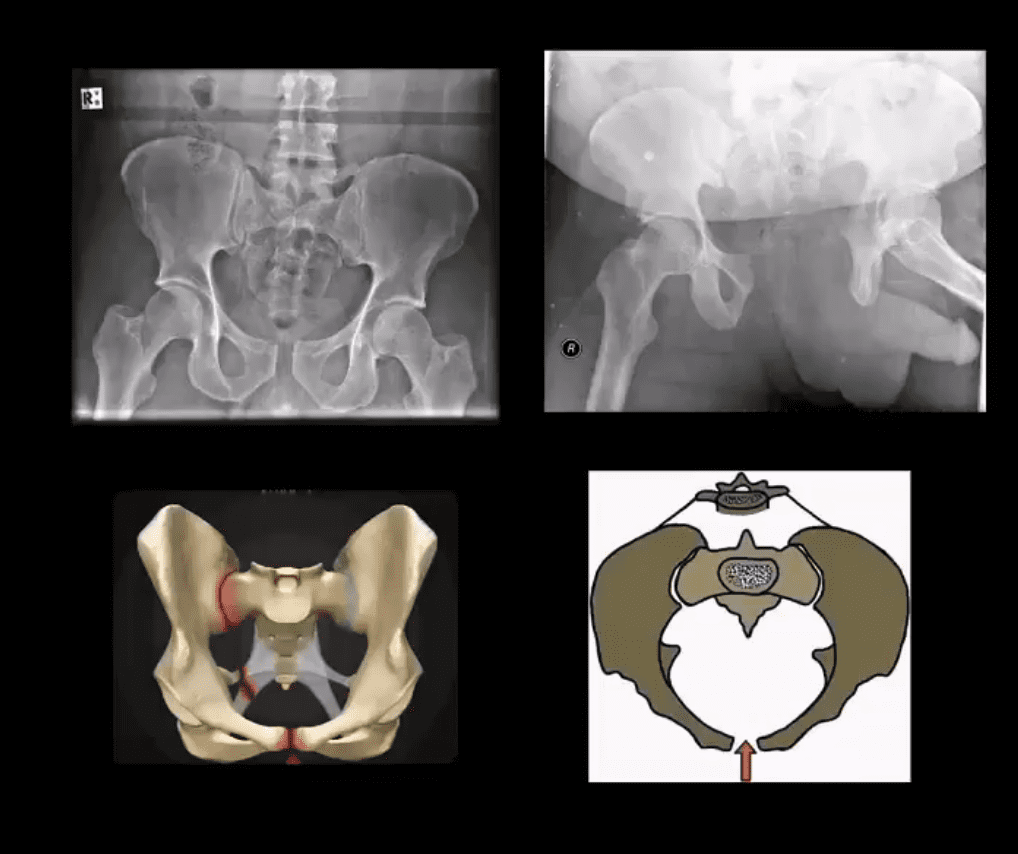
Open Book Pelvis (major instability)
- Mechanism: AP compression of different force magnitude (picture depiction)
- Rad Dx: diastasis of symphysis pubis with diastasis of SIJ with and w/o adjacent Fx of the ala
- Imaging steps: x-radiographic, CT scanning with and w/o contrast for vascular injury, cystography for acute urinary bladder rupture
- Immediate and delayed complications may occur: vascular injury, urethral/bladder injury
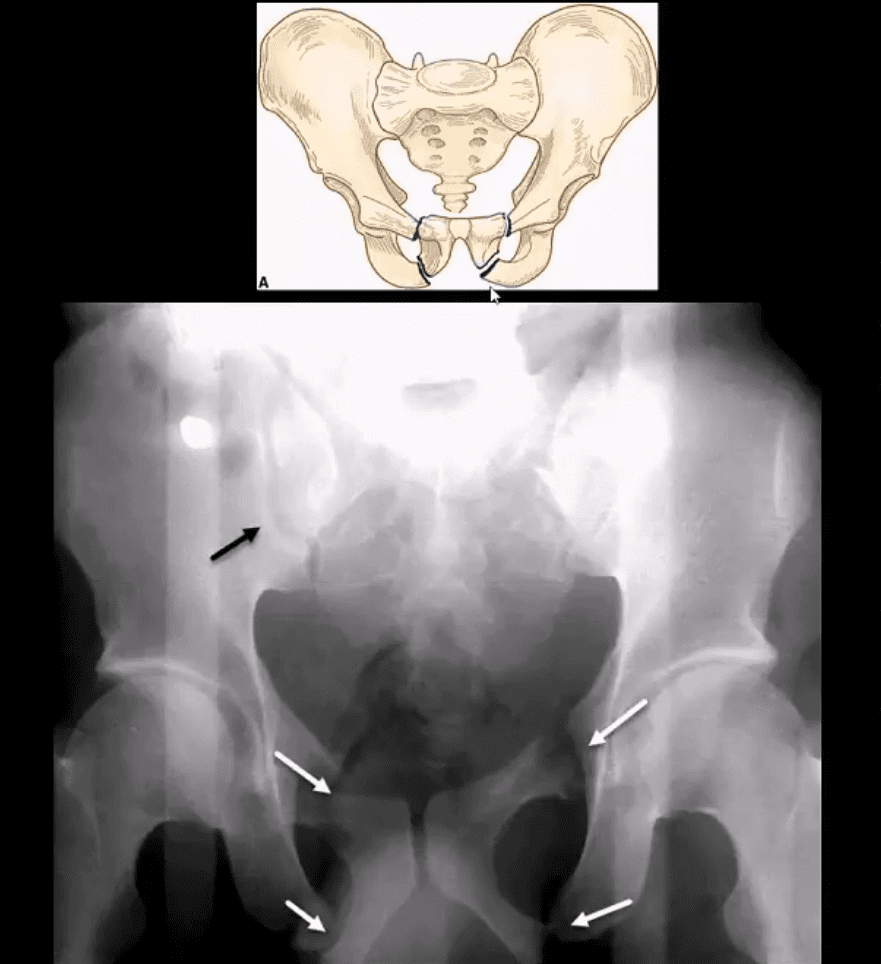
Straddle Injury: Unstable Fx
- Mechanism: direct impact/collision
- High risk of urinary bladder/urethral injury
- Imaging: bilateral superior and inferior pubic rami Fx with or w/o diastasis and Fx of SIJ
- CT with and w/o contrast for vascular injury
- Cystourethrogram additionally evaluates a urogenital injury
- Complications: urethral strictures, bleeding, bladder rupture
- Note: Straddle Fx with right SIJ separation
Hip Fractures (Femoral Neck)
- Common injury
- Occurs in:
- 1) Young adults due to high energy trauma
- 2) Osteoporotic patients with low impact, trivial or no trauma (i.e., insufficiency Fx)
- X-radiography is crucial to early Dx and prevention of complications which include:
- Dx: intra-capsular vs. extra-capsular Fx
- Ischemic osteonecrosis aka avascular necrosis (AVN) of the femoral head and rapid disabling DJD
- Epidemiology: USA has some of the highest rates of OSP hip Fx worldwide. Highest healthcare cost Fx to treat overall
- Women>men, Caucasians>African-Americans
- 25-30% mortality within the 1st year. Mortality depends on co-morbidities and stat of activity prior Fx
- Pathophys: the femoral neck is intra-capsular and transmits arterial flow to the head. The neck is uncovered by the periosteum and unable to develop a good callus. The neck transmits maximum tensile forces through the proximal femur and prone to Fx and non-union
Hip Strengthening
Acute Pelvis & Hip Trauma
Post Disclaimer
Professional Scope of Practice *
The information on this blog site is not intended to replace a one-on-one relationship with a qualified healthcare professional or licensed physician and is not medical advice. We encourage you to make healthcare decisions based on your research and partnership with a qualified healthcare professional.
Blog Information & Scope Discussions
Welcome to El Paso's Premier Wellness and Injury Care Clinic & Wellness Blog, where Dr. Alex Jimenez, DC, FNP-C, a board-certified Family Practice Nurse Practitioner (FNP-BC) and Chiropractor (DC), presents insights on how our team is dedicated to holistic healing and personalized care. Our practice aligns with evidence-based treatment protocols inspired by integrative medicine principles, similar to those found on this site and our family practice-based chiromed.com site, focusing on restoring health naturally for patients of all ages.
Our areas of chiropractic practice include Wellness & Nutrition, Chronic Pain, Personal Injury, Auto Accident Care, Work Injuries, Back Injury, Low Back Pain, Neck Pain, Migraine Headaches, Sports Injuries, Severe Sciatica, Scoliosis, Complex Herniated Discs, Fibromyalgia, Chronic Pain, Complex Injuries, Stress Management, Functional Medicine Treatments, and in-scope care protocols.
Our information scope is limited to chiropractic, musculoskeletal, physical medicine, wellness, contributing etiological viscerosomatic disturbances within clinical presentations, associated somato-visceral reflex clinical dynamics, subluxation complexes, sensitive health issues, and functional medicine articles, topics, and discussions.
We provide and present clinical collaboration with specialists from various disciplines. Each specialist is governed by their professional scope of practice and their jurisdiction of licensure. We use functional health & wellness protocols to treat and support care for the injuries or disorders of the musculoskeletal system.
Our videos, posts, topics, subjects, and insights cover clinical matters and issues that relate to and directly or indirectly support our clinical scope of practice.*
Our office has made a reasonable effort to provide supportive citations and has identified relevant research studies that support our posts. We provide copies of supporting research studies available to regulatory boards and the public upon request.
We understand that we cover matters that require an additional explanation of how they may assist in a particular care plan or treatment protocol; therefore, to discuss the subject matter above further, please feel free to ask Dr. Alex Jimenez, DC, APRN, FNP-BC, or contact us at 915-850-0900.
We are here to help you and your family.
Blessings
Dr. Alex Jimenez DC, MSACP, APRN, FNP-BC*, CCST, IFMCP, CFMP, ATN
email: coach@elpasofunctionalmedicine.com
Licensed as a Doctor of Chiropractic (DC) in Texas & New Mexico*
Texas DC License # TX5807
New Mexico DC License # NM-DC2182
Licensed as a Registered Nurse (RN*) in Texas & Multistate
Texas RN License # 1191402
ANCC FNP-BC: Board Certified Nurse Practitioner*
Compact Status: Multi-State License: Authorized to Practice in 40 States*
Graduate with Honors: ICHS: MSN-FNP (Family Nurse Practitioner Program)
Degree Granted. Master's in Family Practice MSN Diploma (Cum Laude)
Dr. Alex Jimenez, DC, APRN, FNP-BC*, CFMP, IFMCP, ATN, CCST
My Digital Business Card


